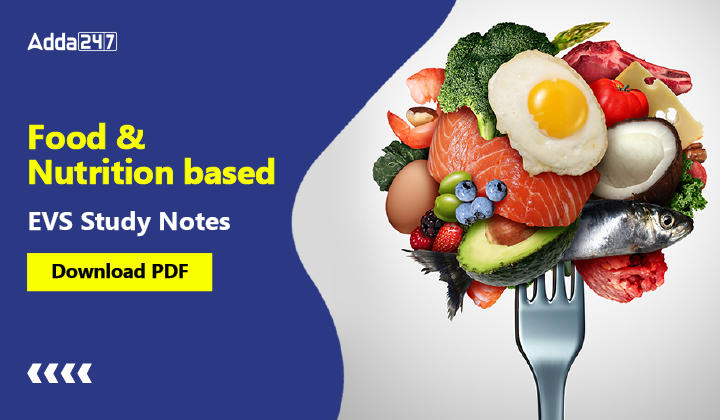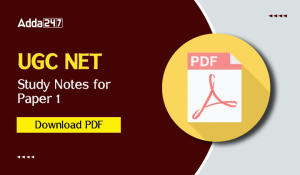Table of Contents
Environmental Studies is an interdisciplinary field that encompasses various branches of study, including chemistry, physical science, life science, agriculture, health, and sanitary engineering. It presents an intriguing subject with 30 questions in CTET and other State TET Exams. The Environmental Science section further divides these questions into two parts: Subject Content, accounting for 15 marks, and EVS Pedagogy, also worth 15 marks. To excel in the CTET Exam, it is recommended to study the NCERT books from class 1 to 8. In this article, we will provide an introductory overview of EVS Pedagogy.
FOOD AND NUTRITION
Foods are the substances which are essential for growth and development of an organism. All living organism need food, some of organisms such as plant make their own food by process of photosynthesis while animals obtain their food from plants and other animal.
Nutrition:
• Process of obtaining nutrients or food is called nutrition.
• Nutrients are the organic or inorganic substances which help in our survival and maintaining proper health.
• On the basis of the quantity required by the body nutrients are classified into two categories:
1. Macro Nutrients: These nutrients are required by body in large amount. E.g. carbohydrate, fat and protein.
2. Micro Nutrients: These nutrients are required only in minute or very small amount. e.g., minerals and vitamins. Micro nutrients basically help in regulation of different functions of body.
Different Components of Food
(a) Carbohydrates:
They are chemically made up of carbon, hydrogen and oxygen. It provides energy to organism and it is primary source of energy to all living being on the Earth.
These are the cheapest sources of energy. There are three types of carbohydrate that animal consume in food. These are (i) Starch, (ii) Sugars (in) Cellulose.
I. Common Sources of Carbohydrates:
• Starch: Cereals (wheat, rice and maize), millets (bajra, jowar, barley roots and tubers (sweet potato, tapioca and potato).
• Sugar: Sugarcane, beet root, fruits (banana, mango, sapota or chiku), milk, honey etc. Cellulose Cell walls of fruits, vegetables and cereals.
• During digestion both starch and sugars are absorbed as glucose. The surplus glucose is changed into glycogen which is stored in the liver for subsequent use.
• Cellulose is a fibrous substance which is not digested by human body. However, it serves as roughage and facilitates bowel (stool) movement.
• A normal person needs about 400-500 grams of carbohydrates daily in the diet. A growing child, a lactating mother and a person doing hard physical work need more carbohydrates than an average person because of their greater energy requirements.
II. Various Functions of Carbohydrates
• Lactose sugar promotes growth of intestinal bacteria that facilitate the absorption of calcium.
• Excess carbohydrates are converted into glycogen and serve as reserve sources of energy.
• Glucose is the only source of energy for the central nervous system.
(b) Fats:
Fats are also compound of carbon, hydrogen and oxygen, but it has more carbon and hydrogen and less oxygen. Fats are member of lipid family; they are insoluble in water but soluble in organic solvent.
• They are richest source of energy but not the primary source of energy. One gram of fat on oxidation gives about 9.0 kcal (37 kilojoules) of energy.
• Fats are obtained from ghee, butter, oil, meat, cheese, milk, cakes, cream etc. Fats perform many functions in the body like
(i) As a source of energy.
(ii) As a component of cell and tissues.
(iii) Fats help in absorption of many fat soluble vitamins (A, D, E, K).
(iv) Fat helps in synthesis of vitamin D and steroid hormone in the body.
(v) Fats are stored in the body and act as an insulator to cold weather and any external shock.
(c) Proteins:
Proteins are complex organic molecule made up of carbon, hydrogen, oxygen, nitrogen mainly but sometimes it also contain sulphur and phosphorus.
• Proteins are made up of many amino acids. So, amino acids are basic units of proteins. Amino acids are of two types
1. Essential Amino Acid: These amino acids are not synthesized in human body so it is very important to take them from outside in the form of food.
2. Non-Essential Amino Acid: These amino acids are synthesized in the animal body.
• Proteins can be obtained from the pulses, legumes, nuts, milk, fish, liver, egg, cheese etc.
• Protein performs many functions and some of them are following
Proteins are the structural component of body and are required in building and maintaining body tissues.
– Enzymes are made up of protein and these enzymes help in digestion so protein play role in digestion.
– Many hormones are made up of protein, so protein plays an important role in regulation of different function of body.
– Protein also plays an important role in transport, e.g. hemoglobin helps in transport of oxygen in the blood
– Proteins help in fighting against any disease and infection.
(d) Vitamins:
• They are chemical substance required by body in very small amount.
• They are essential for proper metabolic functions of body, good health of body and protect body from various diseases.
• Vitamins are not synthesized in body except Vitamin D, so it is important to take them from outside.
• Functions, source and daily requirement of different vitamins are given in the following table:
| Vitamins : Their Functions and Sources | |||
| Vitamin | Daily Requirement for 13 – 15 Year child | Functions | Best and Sources |
|
Vitamin B1 (Thiamine) |
1.3 mg (boys) 1.2 mg (girls) |
Carbohydrate metabolism; sharpens appetite; functioning of heart, nerve and muscles. |
Yeast; liver, milk; cheese; leafy vegetables, meat; whole grain cereals. |
|
Vitamin B2 (Riboflavin) |
1.6 mg (boys) 1.4 mg (girls) |
Carbohydrate and protein metabolism; keeps skin healthy. |
Milk, liver meat: eggs peas, yeast; whole grains; green leafy vegetables. |
| Vitamin B3 (Niacin) |
1.8 mg (boys) 1.5 mg (girls) |
Protein, fat and carbohydrate metabolism. Keeps the skin healthy. |
Fish; eggs; meat; legumes; whole grains; leafy vegetables, peanuts; bean; tomato: potato. |
|
Vitamin B12 (Cyanocobalamin) |
0.2 – 100 mg |
Blood formation, Nervous tissue metabolism, Nucleic acid synthesis. |
Liver; fish; cheese; milk, eggs, meat. |
| Vitamin C (Ascorbic Acid) | 40 mg |
Resistance to infections; keeping teeth, gums and joints healthy; healing of cuts and wounds, maintenance of connective tissue. |
Amia, cabbage; tomatoes, lemon, orange; mangoes; chilies, guava, pineapple; sprouted grams. |
| Vitamin A (Retinol) | 750 mg |
Maintenance of vision and skin; essential for synthesis of visual pigment. |
Milk, cheese, butter, eggs, olive oil, carrots, mangoes, papaya, yellow pumpkin, spinach, sweet potato. |
| Vitamin D | 20 mg |
Keep teeth and bones healthy, absorption of calcium and phosphorous. |
Mild, cheese; egg yolk; fish, fish butter; exposure to sunlight. |
(e) Minerals:
These are also micro-nutrient, they play important role in proper functioning and growth of body.
Minerals are the inorganic component that helps proteins in performing normal functions.
Iodine helps in function of thyroxin hormone; minerals promote growth and development of muscles and bones. It helps in maintaining fluid balance and functioning of nervous system.
• Minerals are categorized into two classes: major elements and minor elements on the basis of their daily requirements.
• Examples of major elements are calcium, phosphorus, potassium, sodium, chlorine and iron. Examples of minor elements are: iodine, magnesium, cobalt etc.
| Minerals : Their Sources and Importance | |||
| Minerals | Sources | Importance | Daily Requirement |
| Iron | Green vegetable like amla, spinach, apple, wheat, jaggery, grains, turnip, meat, eggs. | Formation of hemoglobin | 25 – 30 milligram |
| Calcium |
Green vegetables, milk and milk products, eggs. |
For strong bones and teeth | 1.2 gram |
| Phosphorous |
Eggs, meat, fish, whole, grains, milk |
For strong bones and teeth | 1.2 gram |
| Iodine |
Sea food and iodized salt |
For proper functioning of thyroid gland | 20 milligram |
| Sodium |
Table salt, vegetables, processed food |
Maintain proper fluid balance, nerve transmission and muscle contraction | 2.5 gram |
| Potassium |
Milk, meat, vegetables, fruits |
Maintain fluid balance, nerve transmission and muscle contraction | 1 gram |
| Magnesium |
Vegetables, legumes, nuts and seeds |
Found in bones, important for muscle contraction, importance for protein functioning | Required in very minute amount |
(f) Roughage
It is the fibre present in some food items like fruits and vegetables. Though roughage is not a food, it forms an important part of our diet. Roughage consists mainly of cellulose. Some functions of roughage are
• It helps in bowel movement.
• It cleans our digestive tracts and protects from digestive ailments.
• It prevents constipation.
• It helps in retaining water in the body.
• It helps in maintaining optimum levels of blood sugar and cholesterol
(g) Water:
It is an important constituent of our diet. 75% of an infant body and 70% of an adult body is nothing but water. Various functions of water are as follows
1. Essential for the transport and digestion of food material.
2. Excretes wastes.
3. Maintains the body temperature.
4. Acts as solvent in various reactions in the body.
• Water is obtained by drinking water, fruit juices, milk, tea, coffee, eating vegetables and fruits etc.
(B) Balanced Diet:
To maintain proper health, one needs right type of food in right quantity. The need generally vary with age, sex, type of work and state of body etc. A balanced diet is one that contains all essential nutrients in suitable proportion to provide necessary energy and to keep the body in a healthy state.
A balanced diet has the following qualities
• It meets the nutrient requirement of the body.
• It consists of different types of food items
• It provides adequate amount of energy.
(I) Nutritional Needs for Growing Children:
Growing children need more food in proportion to their body weight. They need
• Extra protein to make new tissues for growth.
• More calcium and phosphorous for formation of bones and muscles cells.
• Vitamin A for the development of healthy eyesight.
• Vitamin C for general health.
• Vitamin D for healthy bones.
(II) Nutritional Needs during Pregnancy and Lactation:
A pregnant woman has to feed the developing embryo and, therefore, has a special need for extra nutrients. Pregnant women and lactating mothers should take
• Extra protein for tissue growth. More calcium and phosphorous to form the bones of the baby.
• More iron for making sufficient blood of the baby.
• More carbohydrates for herself because extra energy is required to carry out all the building processes linked with embryo.
CTET EVS Study Notes PDF
CTET Paper 1 EVS Study Notes PDF on “Food and Nutrition” is a valuable study resource for candidates preparing for the CTET exam 2023. We encourage candidates to download and utilize this comprehensive CTET EVS Study Note PDF to enhance their exam preparation. The direct link to download is provided below for easy access to the simplified access to CTET Paper 1 EVS Study Notes PDF.
Click Here to Access CTET EVS Study Notes PDF on Food and Nutrition




 UGC NET Study Notes for Paper 1, Downloa...
UGC NET Study Notes for Paper 1, Downloa...
 समुद्र का पर्य�...
समुद्र का पर्य�...
 उपमा अलंकार: पर�...
उपमा अलंकार: पर�...














